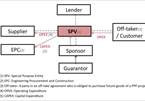 |
|
Le Net and Vu Thanh Minh, lawyers at LNT & Partners
|
Le Net and Vu Thanh Minh, lawyers at LNT & Partners, discuss how latest draft amendments should deal with the major changes in state guarantee, forms of investment, and consistency with other laws.
Over the past two years, the main areas that have applied public-private partnership (PPP) investment are transportation with more than 200 projects, and electricity generation at 23 projects. The main forms of investment have been in build-operate-transfer (BOT) and build-transfer (BT). Therefore, this draft law cannot help but focus on these two forms.
There are some views that investors should not be allowed to invest in the form of BT (where investors build infrastructure projects and the state pays in the form of cash or land exchange) because the total cost cannot be determined via project (risk of self-appreciation of the project) or land value (risk of undervaluation), resulting in loss of the state. Even so, the problem is to overcome the inadequacies of the BT project, not to allow BT project implementation.
Specifically, according to Ronald Coase’s economic theory, the best pricing for the BT project would be through bidding. The fact that most of the schemes have been implemented under the form of contractor designation is the main reason for losses in such projects. To avoid this situation, it is necessary to specify that all BT projects must be conducted through bidding.
Next is the bidding mechanism. The tender invitation document must be carried out by an independent international consultant in order to avoid the design of the documents so that only one bidder can win.
Complete project information must also be made public to avoid a situation where businesses that are assigned to pre-feasibility projects have an information advantage over other businesses. The same principles should be applied to the BOT form. Instead of deploying too many forms of investment, the Law on PPP should focus on BOT and BT also using PPP only for large projects, leaving small projects for socialisation procedures according to the government’s decree on socialisation.
Regarding the influence of the Law on PPP on other laws, the PPP version states that “there is a difference between this law and others on the order, procedures for investment, project implementation, and project enterprise activities.” PPP, applicable laws, investment guarantees, and state capital management mechanisms applied directly to the PPP project shall comply with this law. The question is whether the effect of PPP law on others is large or not, and if there is any risk.
Minimising conflict
First, there are regulations on investment orders and procedures. This part of the Law on PPP is exactly the same as the provisions of the Law on Public Investment and is similar to the provisions of the Law on Planning. Therefore, the regulations in the draft Law on PPP will not cause a major disturbance to the process of approving current investment procedures.
The only difference is the approval process for environmental impact assessment compared to the Law on Environmental Protection. However, this difference is only reflected in the implementation step rather than the implementation content, nor does it affect the environment, so it does not disturb the application of current regulations.
As for the project implementation process, there are more regulations in the draft PPP law than the investment one. However, it still complies with the planning equivalent. Detailed regulations are mainly focused on selecting investors and negotiating project contracts. These are specific provisions and will not conflict with other provisions.
Regarding the land acquisition and land allocation/lease process, the draft PPP does not stipulate, but is based on the provisions of land and environmental laws, and therefore does not cause a major impact.
Operation of PPP enterprise is different from the activities of businesses under the Law on Enterprises, because a PPP business is a type of tool business – thinly capitalised, set out only to be the focal point and implement only one project.
Therefore, the regulations on capital contribution must be consistent with the project progress rather than complying with the 90-day rule under the Law on Enterprises. The businesses of these PPP companies should also be limited to only serve one project.
This does not conflict with the Law on Enterprises, because it provides that if there is a regulation of another specialised law, the provisions of that law will apply.
Regarding state guarantee for the project, the PPP law should note that 70-80 per cent of the capital used for project development is borrowed, and only about 20-30 per cent of the capital is funded by the investor. Therefore, when the state strictly manages its capital, it must also pay attention to the risk that the lending bank bears. PPP projects are large capital projects.
For example, an expressway construction package must be at least 50km, the distance between two toll stations. Meanwhile, the cost of constructing 1km of the expressway could be about $5-15 million. Therefore, the cost of constructing this package will be nearly $500 million, in which the loan will be about $350 million. Banks do not have to use their money to lend but must mobilise capital from the people, or from other financial institutions to lend.
Therefore, as a responsible lender, they have the right to require the project to have a stable cash flow, and always have a backup loan if there is a shortage of capital to complete the project on time. Projects that meet that standard are considered feasible or bankable projects.
Thus, the criterion of bankability is an important criterion for drafting a PPP law. Regulations that affect the bankability criteria need to be revised. Government agencies from top to bottom need to understand banking regulations and criteria to create conditions for banks and investors to meet and unanimously develop the project.
Cutting the debt burden
Bankability does not mean a government guarantee. As the Ministry of Finance feared, the signing of additional government guarantees has increased the public debt. Thus the purpose of enacting a Law on PPP to reduce public debt will not be achieved.
However, it is not possible to consider 100 per cent of the guaranteed amount to be treated as a public debt, because the government guarantee obligation is only a conditional one, and only occurs when there are some specific events, such as lack of foreign currency.
There is a need for a chapter in the PPP law to enable independent consultants to assist government agencies to calculate risks when providing guarantees, as well as the level of probability calculations that need to be guaranteed (for example, 10 per cent, or 5 per cent) to account for public debt, not 100 per cent. This would provide the state with a more open mechanism to provide some guarantees.
Among the guarantees, the three most important issues are the assurance of foreign currency conversion, assurance of minimum revenue to pay off debt, and payment guarantee in case of early termination of a contract.
As for the guarantee of foreign currency conversion, the guarantee of only 30 per cent according to the current regulations in the draft cannot be reassuring for investors. However, in the context of Vietnam's foreign exchange reserves of over $80 billion, the effect of this commitment, on the foreign exchange demand of a project (usually under $100 million for a $500 million project) is not really unacceptable.
For minimum revenue guarantees, the current provision for sharing 50 per cent of the shortfall revenue is fair, provided that it will be refunded from the excess revenue during the surplus years. However, there should be a mechanism to quickly disburse this amount of 50 per cent, not to then be included in the medium and long-term disbursement plan.
The best way is to set up a stabilisation fund and pay for the shortage of revenue. At the same time, investors who want to use the capital from this fund must make annual payment to that fund. At that time, the fund will act as an intermediary mechanism for risk-sharing of PPP investors, and cover state losses when risks occur.
Because PPP projects are public-driven, the government should not set a goal of always being profitable. The benefits of the state cannot be measured in money, such as the benefits of population expansion, economic stimulus, energy security, among others. It should be clearly specified in the annual budget, and there is a budgetary expense to set up this fund.
These funds are also experienced by other countries, called a viability gap fund. The draft law should follow the direction of fund establishment and consider this a strategy to attract investment and an exception to the current direction – that new funds should not be established.
For payment guarantees at the termination of the project, the government should have specific provisions on the rate of payment (so that the investor is partly at risk), and the project cost must be publicised immediately at the beginning. In addition, there should be provisions on the audit of project costs according to the revenue package.
If it is not possible to manage the cost according to the state budget, it should be contracted so that investors and lenders are aware to make proper arrangements. Currently, the draft Law on PPP does not provide for this and needs to be specified in decrees guiding implementation of the law.
If these comments are integrated, especially those on reducing administrative procedures providing investors with a guarantee of revenue, we believe that this law will meet investor expectations as well as reduce the public debt burden on the state. VIR

Crafting a workable PPP law in 2020
Le Net and Vu Thi Thinh from LNT & Partners discuss how important public-private partnerships are to the country’s infrastructure development.

Infrastructure developers await law on PPP
The National Assembly is working on an investment law on public-private partnerships (PPP) which investors hope will settle legal conflicts.
 The long-awaited draft Law on Public-Private Partnerships is being completed with some issues of special attention among international and domestic private ventures being revised in order to increase bankability and to help reduce public debt.
The long-awaited draft Law on Public-Private Partnerships is being completed with some issues of special attention among international and domestic private ventures being revised in order to increase bankability and to help reduce public debt.